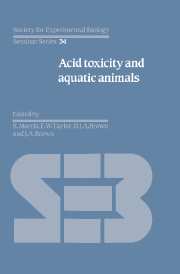Book contents
- Frontmatter
- Contents
- Contributors
- Units, Symbols and Formulae
- Preface
- Introduction: The causes and consequences of surface water acidification
- Invertebrate communities in acid streams
- Fish survival in acid waters
- Field studies on fisheries in acid waters in the UK
- Episodic changes in water quality and their effects on fish
- Acid–base regulation in fishes: 1. Mechanisms
- Acid–base regulation in fishes: 2. Biological responses and limitations
- Intracellular pH regulation and the effects of external acidification
- The physiological problems of fish in acid waters
- Laboratory studies on invertebrate survival and physiology in acid waters
- The physiological problems of crayfish in acid waters
- The effects of hydrogen and aluminium ions on fish gills
- The combined effects of pH and trace metals on fish ionoregulation
- Endocrine responses to acid stress in fish
- Commentary and conclusions
- Index
Intracellular pH regulation and the effects of external acidification
Published online by Cambridge University Press: 05 February 2012
- Frontmatter
- Contents
- Contributors
- Units, Symbols and Formulae
- Preface
- Introduction: The causes and consequences of surface water acidification
- Invertebrate communities in acid streams
- Fish survival in acid waters
- Field studies on fisheries in acid waters in the UK
- Episodic changes in water quality and their effects on fish
- Acid–base regulation in fishes: 1. Mechanisms
- Acid–base regulation in fishes: 2. Biological responses and limitations
- Intracellular pH regulation and the effects of external acidification
- The physiological problems of fish in acid waters
- Laboratory studies on invertebrate survival and physiology in acid waters
- The physiological problems of crayfish in acid waters
- The effects of hydrogen and aluminium ions on fish gills
- The combined effects of pH and trace metals on fish ionoregulation
- Endocrine responses to acid stress in fish
- Commentary and conclusions
- Index
Summary
Introduction
Most measurements of the effects of acid toxicity on aquatic animals concentrate upon changes in body fluid pH and the flux of ions between water and blood. One problem posed by a low blood pH is the potential acidification of the tissues which could cause undesirable deviation from the optimum pH of intracellular enzymes. This chapter examines the techniques and results of investigations into the regulation of intracellular pH (pHi).
Relatively little is known about pHi in most animals, experiments being so far generally confined to those with large neurones. This is because until recently the only way of following pHi over long periods was with pH-sensitive microelectrodes. This method is still the best, but requires both skill and a large cell. For small cells fluorescent dyes are very promising.
In this chapter I will describe some of the evidence on which the present understanding of pHi regulatory mechanisms in snail, crayfish and leech neurones is based. I will confine this chapter to these preparations because they are reasonably typical, and I lack the space for a full review. I will then consider the effects of external acidification before concluding that maintenance of a constant pHi depends very much on a constant external pH. For a detailed review of intracellular pH, see Roos & Boron (1981), but for shorter and more recent accounts of the subject see Thomas (1984, 1986).
- Type
- Chapter
- Information
- Acid Toxicity and Aquatic Animals , pp. 113 - 124Publisher: Cambridge University PressPrint publication year: 1989



